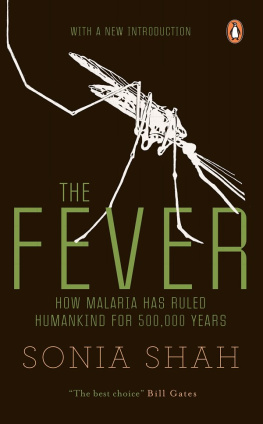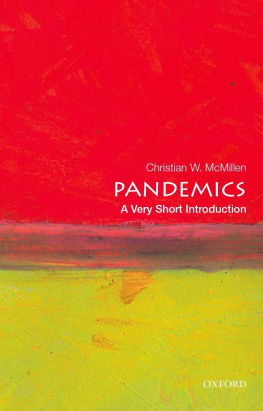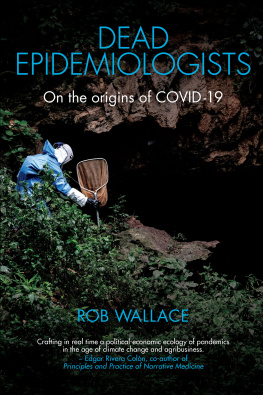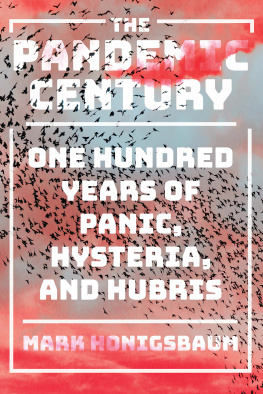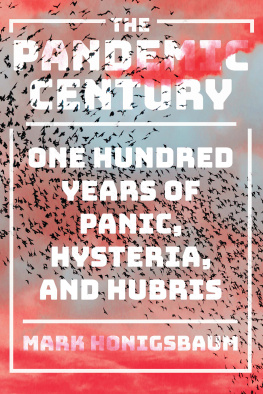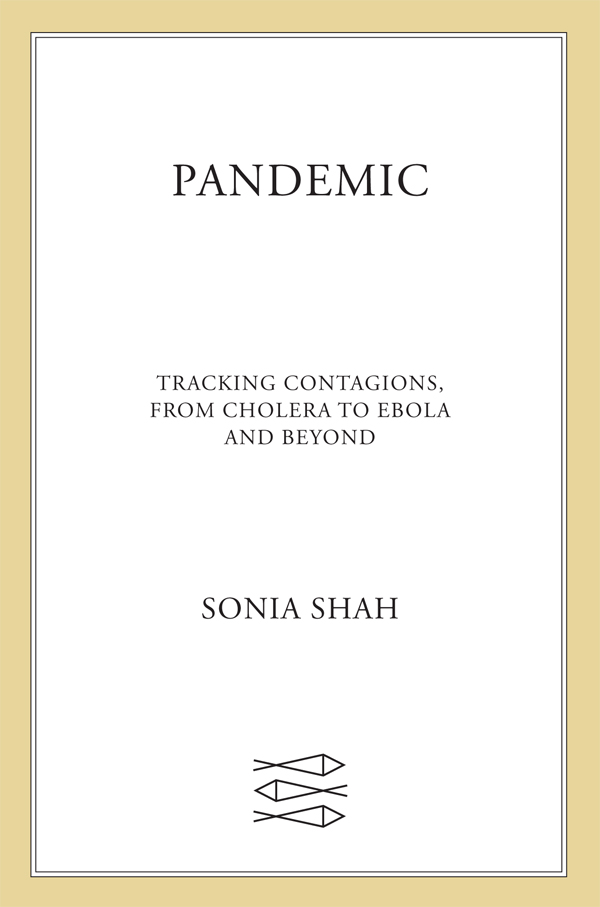Contents
Guide

The author and publisher have provided this e-book to you for your personal use only. You may not make this e-book publicly available in any way. Copyright infringement is against the law. If you believe the copy of this e-book you are reading infringes on the authors copyright, please notify the publisher at: us.macmillanusa.com/piracy.
pandemic : from the Greek pan all + dmos people.
A disease outbreak that spreads throughout an entire country, continent, or the whole world .
But what does it mean, the plague? Its life, thats all.
Albert Camus
Cholera kills people fast. Theres no drawn-out sequence of progressive debility. The newly infected person feels fine at first. Then half a day passes, and cholera has drained his or her body of its fluids, leaving a withered blue corpse.
Thats why, even after being infected, you could, say, eat a decent breakfast at your hotel, of sunny-side-up eggs and tepid juice. You could drive over dusty, potholed roads to the airport. Youd feel perfectly well enough to withstand the long queues there. Even as the killer silently brewed in your gut, youd push your bags through security, perhaps even pick up a croissant at the coffee shop and enjoy a brief respite in a cool molded-plastic chair at the gate before a crackly PA announced the boarding of your flight.
It would only be after youd shuffled down the planes aisles and found your lightly tattered upholstered seat that the stranger within would make itself known, in a deadly, explosive onslaught of excretion, and your trip overseas would be suddenly and cruelly curtailed. Without the benefit of modern medicine rapidly administered, youd be faced with a fiftyfifty chance of survival.
Such was the fate of a passenger ahead of me in line for Spirit Air Flight 952, from Port-au-Prince, Haiti, to Fort Lauderdale, Florida, in the summer of 2013. At the moment that cholera overcame the man, the rest of us were crammed inside a sweltering hall between the gate and the airplane, preparing to board. We waited there while the plane underwent an emergency disinfection. The airline didnt tell us what had caused the sudden hour-long delay. When an airline worker sprinted out of the plane through the hall to gather more supplies, impatient passengers bombarded him with a chorus of questions. He yelled out over his shoulder, by way of explanation, A man shit himself. In Haiti, in the midst of a devastating cholera epidemic, there was little doubt as to what had happened.
If the stricken man had been infected an hour or two later, and sickened after wed all taken our seats, with our arms jostling next to his on narrow strips of shared armrests, our knees grazing his, our hands brushing the overhead bins hed touched, the pathogen might have been able to roost inside our bodies, too. I had spent my trip traipsing around to cholera treatment clinics and cholera-struck neighborhoods to see cholera firsthand. This formidable pathogen had nearly joined me on my flight home.
* * *
The disease-causing microbe, or pathogen, that will cause the worlds next pandemic lurks among us today. We dont know its name or where it comes from. But for now call it choleras child, because what we do know is that it will likely follow the path that cholera blazed.
Cholera is one of only a handful of pathogensincluding bubonic plague, influenza, smallpox, and HIVthat in modern times have been able to cause pandemics, contagions that spread widely among human populations. Among them, it stands alone. Unlike the plague, smallpox, and influenza, choleras emergence and spread were well documented from the beginning. Two centuries after it first emerged, it remains exceptionally potent, with an undiminished power to cause death and disruption, as its display on Flight 952 showed. And unlike relative newcomers like HIV, choleras an old hand at pandemics. So far, its caused seven, the latest hitting Haiti in 2010.
Today cholera is known primarily as a disease that affects impoverished countries, but that wasnt always so. In the nineteenth century, cholera struck the most modern, prosperous cities in the world, killing rich and poor alike, from Paris and London to New York City and New Orleans. In 1836, it felled King Charles X in Italy; in 1849, President James Polk in New Orleans; in 1893, the composer Pyotr Ilyich Tchaikovsky in St. Petersburg. Over the course of the nineteenth century, cholera sickened hundreds of millions, killing more than half of its victims. It was one of the fastest-moving, most feared pathogens in the world.
The microbe that causes the disease, Vibrio cholerae , was introduced into human populations during the era of British colonization of the South Asian hinterlands. But it was the rapid changes of the Industrial Revolution that provided the opportunities that turned the microbe into a pandemic-causing pathogen. New modes of travelsteamships, canals, and railwaysferried Vibrio cholerae deep into Europe and North America. The crowded and unsanitary conditions of rapidly growing cities allowed the bacteria to efficiently infect scores at a time.
Repeated epidemics of cholera posed a potent challenge to the political and social institutions of the societies it afflicted. Containing the disease called for a level of international cooperation, effective municipal governance, and social cohesion that had yet to be forged in newly industrialized cities and towns. Discovering its cureclean waterrequired that doctors and scientists transcend long-held conventional wisdom about health and the spread of disease.
It took nearly a hundred years of deadly cholera pandemics for cities like New York, Paris, and London to rise to choleras provocations. To do it, they had to remake the way they housed themselves, managed their drinking water and their waste, governed the publics health, conducted international relations, and understood the science of health and disease.
Such is the transformative power of pandemics.
* * *
The medical and public-health advances developed to contain nineteenth-century pathogens like cholera were so effective that for most of the twentieth century, the conventional wisdom among epidemiologists, medical historians, and other experts was that developed societies had vanquished infectious diseases for good. Western society had achieved the virtual elimination of infectious diseases as a significant factor in social life, the virologist Sir Macfarlane Burnet wrote in 1951.
According to the popular theory of epidemiological transitions, first articulated by the Egyptian scholar Abdel Omran, the demise of infectious diseases in wealthy societies was an inevitable result of economic development. As societies prospered, their disease profile shifted. Instead of being plagued by contagion, they suffered primarily from slow-moving, chronic, noncommunicable conditions, like heart disease and cancer.
I confess to once being a true believer in this theory. I knew from visiting places like the south Mumbai ghetto where my father had grown up that societies that suffered significant burdens of infectious diseases were indeed crowded, unsanitary, and impoverished. We stayed in south Mumbai every summer, crammed with relatives into two-room flats in a dilapidated tenement building. Like the hundreds of other residents, we flung our waste into the courtyard, carried our own water in aging plastic buckets to shared latrines, and fitted two-foot boards over the thresholds to keep out the rats. Thereas in other crowded, waste-ridden, poorly plumbed societiesinfection was a constant reality.


